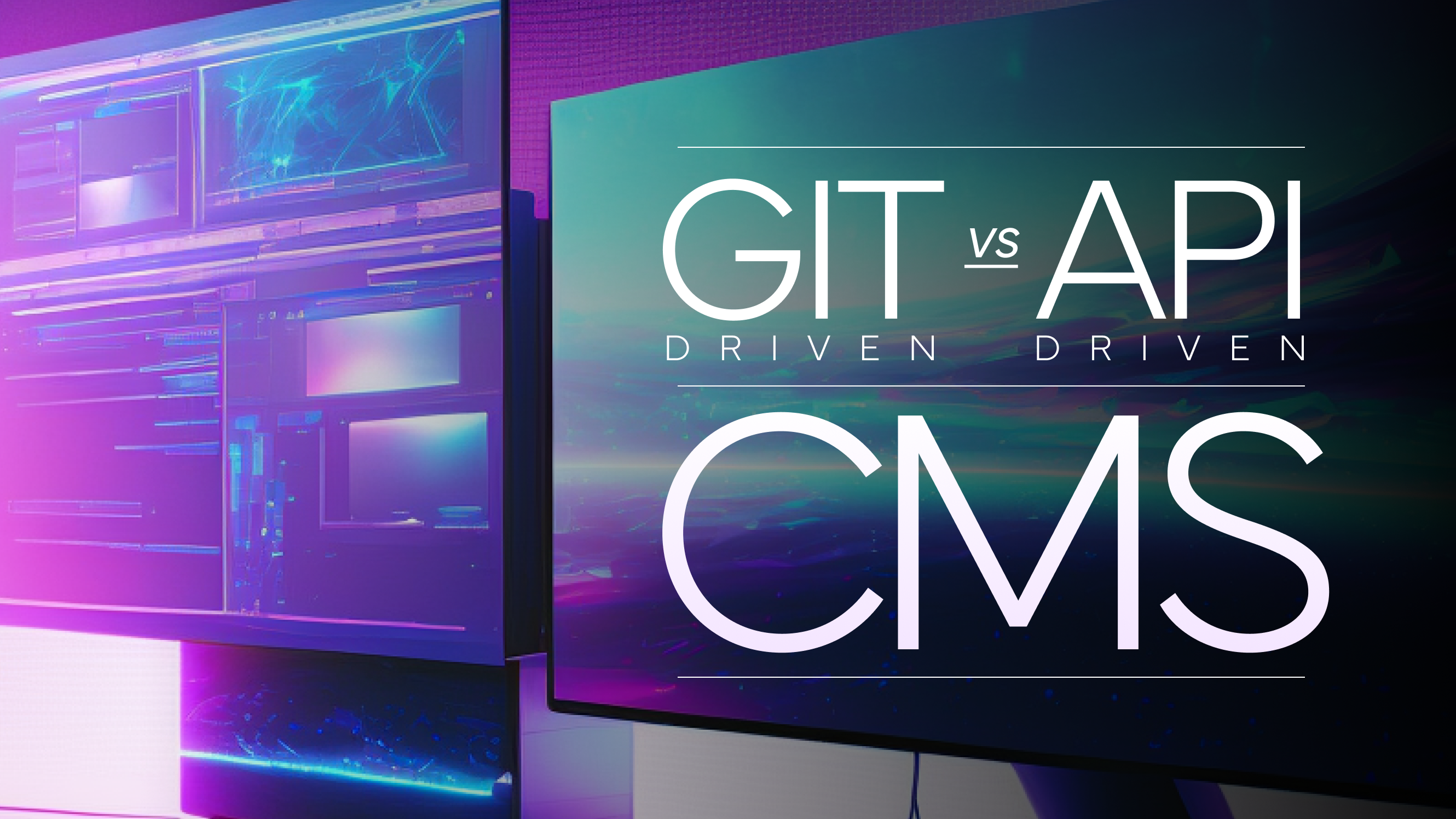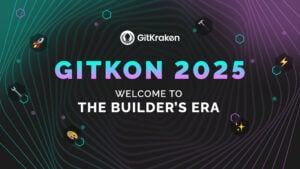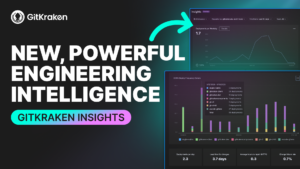Content management is shifting toward two headless options: Git-based and API-driven. Headless CMS solutions allow developers to edit and manage content easily while still using the front- and back-end tools and platforms they know and love. These Git-based and API-driven CMS solutions give developers a new way to expedite CI/CD processes without compromising product quality.
Git is an essential tool for both beginners and seasoned software developers. According to our recent survey, 95% of respondents actively use Git in their current projects. As such, Git-based CMS can have great impacts on developers and teams. Looking to learn Git and develop actionable skills quickly? Check out our top resources for learning Git.
But API-driven CMS also has advantages for new and veteran developers. While Git-based CMS acts as a layer on top of Git to interact with Git repositories directly, API-driven CMS enables users to choose which framework and language they would like to work with. Which one is right for you? Let’s discuss the pros, cons, benefits, and challenges of each type so that you can decide which is the best fit for you.
What is Headless CMS?
Traditional CMSs like WordPress and Drupal are built into a single web-first application with both back- and front-end capabilities. Since over 360 million domains are registered worldwide, traditional CMS is usually enough to meet the needs of budding developers and those with little to no coding knowledge.
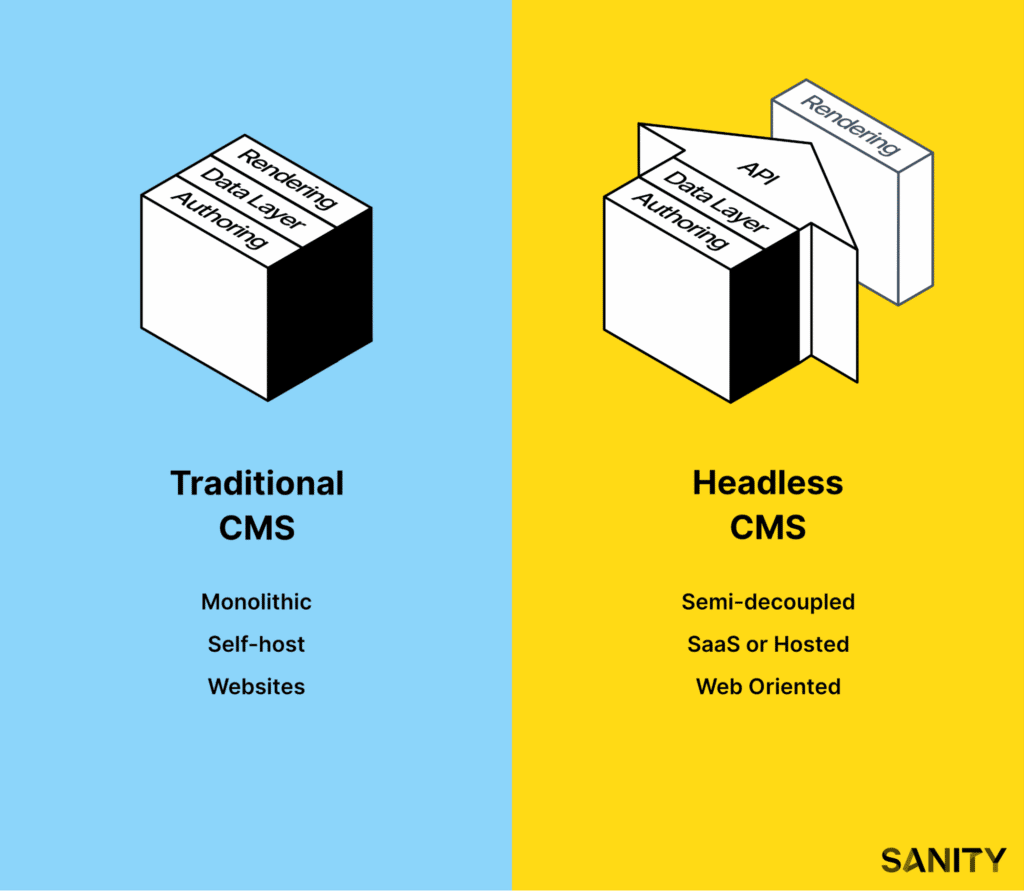
Headless solutions offer professional developers more control over their implementations and enable teams to create more consistent CI/CD pipelines. It also enables teams to repurpose content across several front ends. Headless CMS separates content management from front-end presentation layers so developers can deliver content beyond apps and websites.
Git-based CMS
When working with a Git-based CMS, developers are essentially working with files that are already saved to their repository. Git-based CMS solutions behave like a layer on top of Git that interacts directly with Git repositories. Some of the most popular Git-based CMSs include Forestry, Publii, and Prose, but there are many more to choose from.
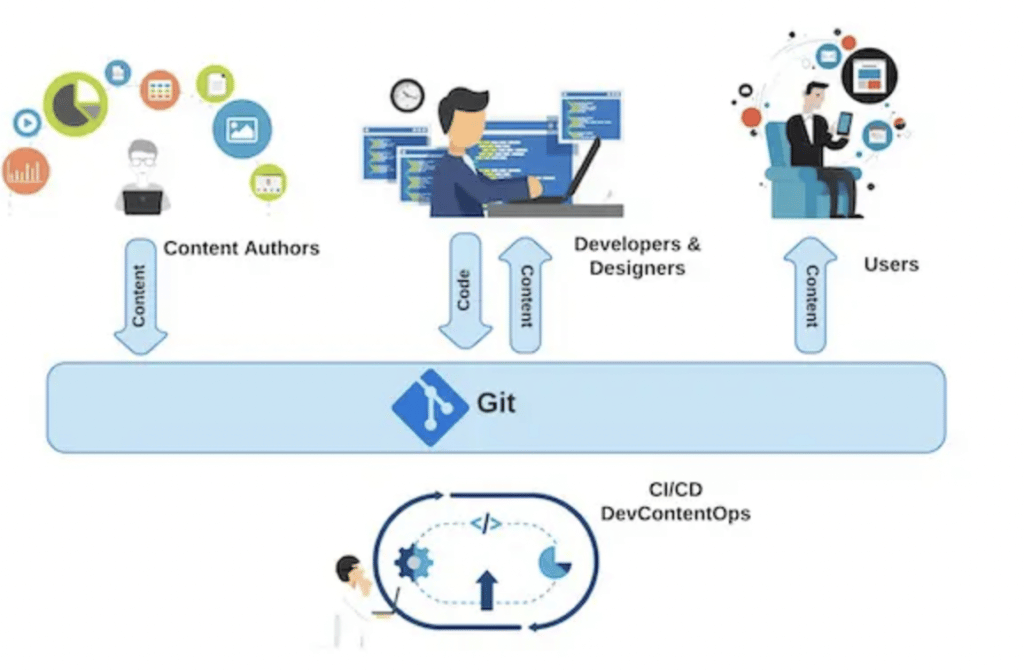
Before we dive into the benefits and challenges, let’s take a high-level look at the pros and cons of using Git-based CMS:
Pros
- Full version control of content
- Content exists as flat files so developers can use their usual tools
- Simple to roll back
- Homogenous approach with Git-based workflows
- No data or bandwidth limitations
- Easy to set up
Git-based CMS blends seamlessly with Git repositories and the tools that developers are already using. Since it’s essentially a layer on top of your Git layer, there are virtually no data limitations besides what is written into your code.
Cons
- Unable to pull content from several apps and websites with the same CMS
- Limited posting abilities
- Not suited for websites with large amounts of content
- Limited control over content formatting
- Repository size limits mean that developers might need a separate service for media files
Although Git-based CMS is helpful for teams that develop using Git repositories, it can be a little more complicated for those that regularly post large media files to their projects. Additionally, content formatting is strictly limited to Git, which means it cannot pull content across several presentations.
Benefits of Git-based CMS
Now that we’ve gone over some basics, let’s learn a little more about the positives of working with Git-based CMSs.
Multi-object Versioning
Traditional CMS platforms are limited in their building capabilities. Limited versioning means that traditional solutions must maintain cumbersome data structures or track single-object graphs. For common developers, limited versioning is not a deal breaker.
Multi-object versioning with Git-based CMS gives organizations an advantage. When backed by a Git-based solution, it allows specific content change tracking at the file level. And because all content is stored as flat files, it can easily be moved from testing, to development and production environments and between systems.
Distributed Repository and Branching
With Git-based CMS, distributed versioning and workflow management are simplified. Traditional CMSs require developers to work directly within the CMS. But Git-based CMS developers can work locally and still make changes in the CMS. Instead of being forced to use intermediary tools, developers can still use the tools they work with daily without limitations.
With branching, teams can create unlimited staging environments and previews to visualize development processes and make it easier to work in teams. Developers and authors can do it all with Git-based CMS. They can experiment with new features, work on major site enhancements, and manage content distribution all in one.
Ownership
Finally, the last major benefit to developers working with Git-based CMS is ownership. Content data is all stored in local repository files, so developers are the sole owners of the content by default. That means that developers are free to move content from CMS to CMS without legal ramifications. De facto ownership solves many common Git mistakes that both seasoned professionals and noob developers often fall into when it comes to transferring and distributing content.
Challenges of Git-based CMS
With all the great things that Git-based CMS allow developers to do with their content, there are a few challenges to watch out for.
Relationships in Git-based CMS
Relationships are hugely important for modeling and keeping content in check. The main issues associated with current Git-based CMS solutions are that they are often too simple and easily break without increased oversight and regular maintenance.
Special Measures for SEO are Required
SEO is also a crucial factor for online brands, but Git doesn’t come with any specific support to help improve technical SEO. Developers using Git-based CMS that want to improve their online visibility will need to generate sitemaps, use metatags effectively, open graph tags, and use mobile-friendly themes.
GitHub Doesn’t Run Plugins
The biggest issue developers run into using Get-based CMSs is that GitHub doesn’t run plugins. While many developers coding in Git are aware of this limitation and push locally generated content to customize certain features, it does push back the time to release.
API-driven CMS
API-driven CMS is another type of headless CMS that serves content through an API. This allows developers to decouple content from the presentation completely. That means you get the data as it is structured, but it depends on you to decide how you will work with that content. Some of the most popular API-driven CMSs include Prismic, Ghost, and Strapi. But just as with Git-based CMSs, there are numerous API-first solutions to choose from.
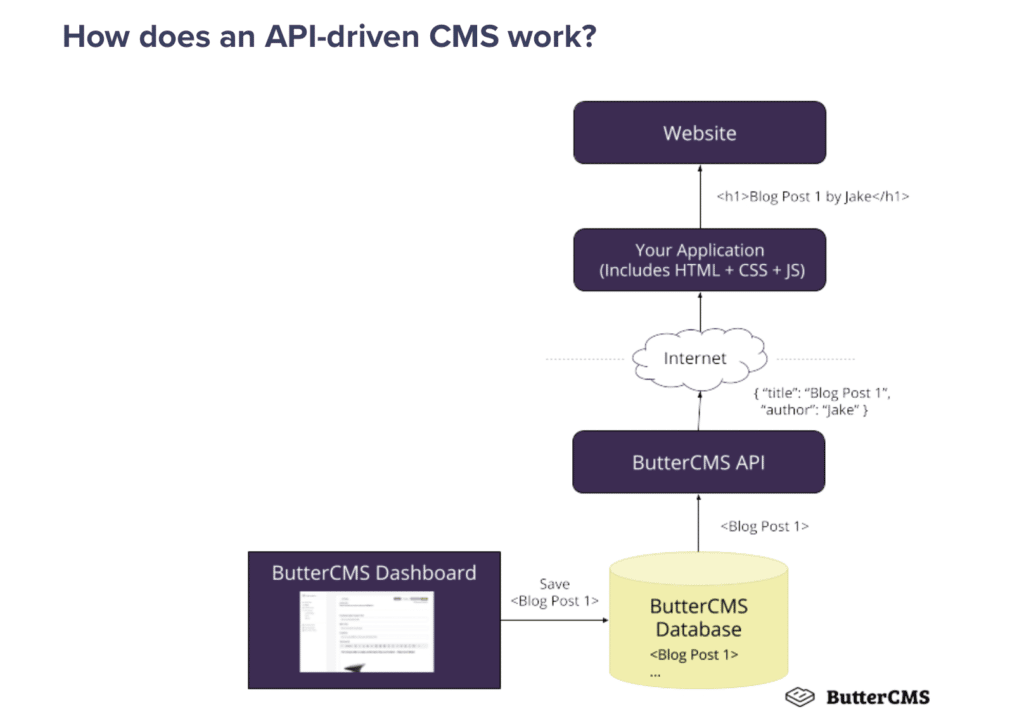
Here is a quick overview of the pros and cons of working with API-driven CMS:
Pros
- Distributes the same managed content across different apps and websites
- Have the ability to use content with multiple front ends
- Most are completely customizable
- Easily handles large amounts of data
- Includes asset management features
Cons
- Not integrated into developer workflows
- Storage and usage limits
- Heavily dependent on developers for major changes
Benefits of API-driven CMS
As you can see, API-driven CMS has more features than Git-based CMS, but the cons can outweigh the pros for some implementations. Let’s take a closer look at the benefits of working with API-driven CMS.
Existing Ecosystem
One of the reasons why API-driven CMS solutions are growing in popularity is that they integrate well with existing ecosystems. The best solutions also help teams enforce best practices and minimize errors by using the appropriate endpoints within the API. This means that developers can freely integrate tools like CRM, analytics, and automation and remove them anytime. That way, brands can change their digital experiences and platforms as soon as customer sentiments change.
Reach out to Consumers on Several Different Devices
API-driven CMSs also enable organizations to connect to consumers on several different devices. IoT devices like tablets, smartphones, and other enabled devices are becoming more widespread since they are usually less costly than computers and PCs. But traditional CMS platforms can’t deliver customized experiences at the device level. However, API-driven CMSs can when APIs are developed for specific touchpoints, making customization virtually limitless.
Faster Content Repurposing
API-driven CMS stores content in a central location, making it easy to deliver to any channel. Content creators can create one piece of content and then use CMS to repurpose it for new channels, different devices, and different audiences. This is a huge benefit for companies with a digital-first mindset using an omnichannel marketing approach. It saves time and eliminates the need to create brand-new content for each channel.
Challenges of API-driven CMS
API-driven CMSs come with a robust list of benefits, but there are certain challenges that developers should watch out for.
Too Reliant on Web Devs
API-driven CMS solutions heavily rely on developers to create custom front-ends. This means more work for teams and creates a need for improved communication between marketing and development teams.
Content Preview is a Problem
API-driven CMSs don’t always allow developers to preview content before it’s published. The back-end editor allows content creators to input their content directly into the API, but it’s challenging to publish content without seeing how the pages behave from the user’s perspective. This leaves little room for mistakes, so developers and creators must be sure that they are making accurate changes.
Cost
API-driven CMSs can be more costly than traditional and Git-based CMS solutions. Even open-source API-driven CMS will require organizations to pay for infrastructure costs like hosting and CDNs, staffing costs like developers and quality assurance engineers, and production costs like maintenance and security.
Git-based CMS vs. API-driven CMS
Regarding Git-based CMS vs. API-driven CMS, neither one is better than the other. It all depends on your needs as a developer, the talents of the teams you work with, and the product outcomes that your clients expect. If you work alone or with a set team, making the choice can be simple. But it gets more difficult the more personnel that are involved.
Many organizations and developers choose to outsource software projects when time is tight and deadlines are approaching. In this case, the cost can be a significant factor. Most freelance software developers require a retainer of $150-275 an hour, and that price goes up with experience and expertise. There are many Git-based and API-based CMS options at various price points, so you’re bound to find an option that fits within your budget.
However, considering your content is the best way to decide between the two options. The main difference between these headless CMS types is how content is stored and consumed. This is a crucial driving force when deciding which solution is best for you.
How to Choose
Switching to a headless CMS means making a choice between Git-based and API-driven solutions. While each project will require a different level of customization, your overall development process should stay the same. If you’re still trying to decide which option is right for you and your teams, make sure that you have a solid development strategy in place that is flexible enough to accommodate unique project requirements but rigid enough to provide structure for CI/CD processes.
Ask yourself, what is my skill level? Can my teams efficiently use API tools? How quickly do clients expect iterations? What repositories do you use the most? How well does your team understand various coding languages? Now take a second look at the pros, cons, benefits, and challenges of these two headless CMS options. And before you finally settle, be sure that you understand the tech behind the tools before landing on either a Git-based or API-driven solution.
 GitKraken MCP
GitKraken MCP GitKraken Insights
GitKraken Insights Dev Team Automations
Dev Team Automations AI & Security Controls
AI & Security Controls